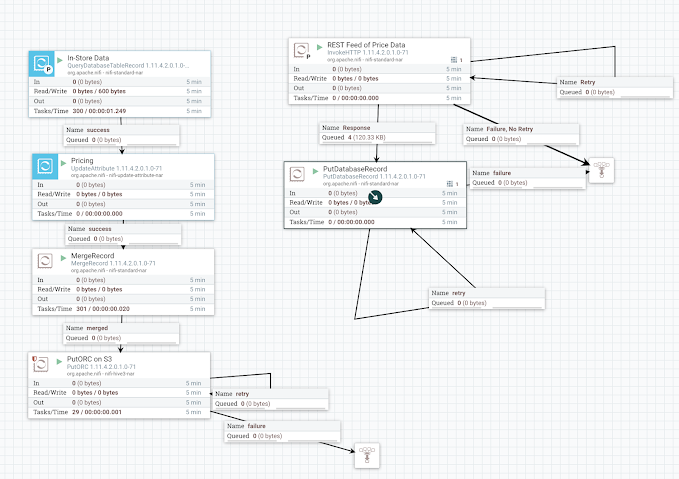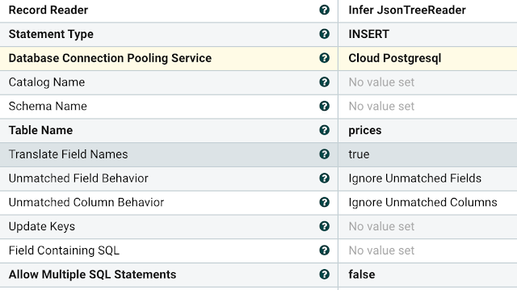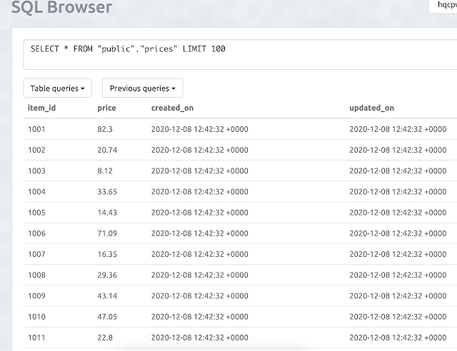Community Articles
- Cloudera Community
- Support
- Community Articles
- Simple Change Data Capture (CDC) with SQL Selects ...
- Subscribe to RSS Feed
- Mark as New
- Mark as Read
- Bookmark
- Subscribe
- Printer Friendly Page
- Report Inappropriate Content
- Subscribe to RSS Feed
- Mark as New
- Mark as Read
- Bookmark
- Subscribe
- Printer Friendly Page
- Report Inappropriate Content
Created on
12-23-2020
09:18 AM
- edited on
12-23-2020
05:18 PM
by
subratadas

Other times you need something easier for just some basic changes and inserts to some tables you are interested in receiving new data as events. Apache NiFi can do this easily for you with QueryDatabaseTableRecord. You don't need to know anything, but the database connection information, table name and what field may change. NiFi will query, watch state and give you new records. Nothing is hardcoded, parameterize those values and you have a generic 'Any RDBMS' to 'Any Other Store' data pipeline. We are reading as records, which means each FlowFile in NiFi can have thousands of records that we know all the fields, types and schema related information for. This can be ones that NiFi infers the schema or ones we use to form a Schema Registry like Cloudera's amazing Open Source Schema Registry.
Let's see what data is in our PostgreSQL table:
How To
- QueryDatabaseTableRecord (we will output JSON records, but could have done Parquet, XML, CSV or AVRO)
- UpdateAttribute - optional - set a table and schema name, can do with parameters as well.
- MergeRecord - optional - let's batch these up.
- PutORC - let's send these records to HDFS (which could be on bare metal disks, GCS, S3, Azure or ADLS). This will build us an external Hive table.

PutORC


Add-Ons Examples
- PutKudu
- PutHDFS (send as JSON, CSV, Parquet) and build an Impala or Hive table on top as external
- PutHive3Streaming (Hive 3 ACID Tables)
- PutS3
- PutAzureDataLakeStorage
- PutHBaseRecord
- PublishKafkaRecord_2_* - send a copy to Kafka for Flink SQL, Spark Streaming, Spring, etc...
- PutBigQueryStreaming (Google)
- PutCassandraRecord
- PutDatabaseRecord - let's send to another JDBC Datastore
- PutDruidRecord - Druid is a cool datastore, check it out on CDP Public Cloud
- PutElasticSearchRecord
- PutMongoRecord
- PutSolrRecord
- PutRecord (to many RecordSinkServices like Databases, Kafka, Prometheus, Scripted and Site-to-Site)
- PutParquet (store to HDFS as Parquet files)
These records can be also manipulated ETL/ELT style with Record processing in stream with options such as:
- QueryRecord (use Calcite ANSI SQL to query and transform records and can also change output type)
- JoltTransformRecord (use JOLT against any record not just JSON)
- LookupRecord (to match against Lookup services like caches, Kudu, REST services, ML models, HBase and more)
- PartitionRecord (to break up into like groups)
- SplitRecord (to break up record groups into records)
- UpdateRecord (update values in fields, often paired with LookupRecord)
- ValidateRecord (check against a schema and check for extra fields)
- GeoEnrichIPRecord
- ConvertRecord (change between types like JSON to CSV)
When you use PutORC, it will give you the details on building your external table. You can do a PutHiveQL to auto-build this table, but most companies want this done by a DBA.
CREATE EXTERNAL TABLE IF NOT EXISTS `pricesorc` (`item_id` BIGINT, `price` DOUBLE, `created_on` BIGINT, `updated_on` BIGINT)
STORED AS ORC
LOCATION '/user/tspann/prices'
Part 2
REST to Database
Let's reverse this now. Sometimes you want to take data, say from a REST service and store it to a JDBC datastore.
- InvokeHTTP (read from a REST endpoint)
- PutDatabaseRecord (put JSON to our JDBC store).

REST Output

Database Connection Pool

Get the REST Data

PutDatabaseRecord

From ApacheCon 2020, John Kuchmek does a great talk on Incrementally Streaming RDBMS Data.
Resources
- https://www.datainmotion.dev/2019/10/migrating-apache-flume-flows-to-apache_15.html
- https://github.com/tspannhw/EverythingApacheNiFi/blob/main/README.md
- https://www.youtube.com/watch?v=XsL63ZQYmLE
- https://community.cloudera.com/t5/Community-Articles/Change-Data-Capture-CDC-with-Apache-NiFi-Part-1...
- https://nifi.apache.org/docs/nifi-docs/components/org.apache.nifi/nifi-cdc-mysql-nar/1.5.0/org.apach...
- https://dzone.com/articles/change-data-capture-using-apache-nifi
- https://www.linkedin.com/pulse/building-near-real-time-big-data-lake-part-2-boris-tyukin/
- https://www.qlik.com/us/data-management/nifi
- https://www.cloudera.com/tutorials/cdp-importing-rdbms-data-into-hive.html
- https://www.cdata.com/kb/tech/oracledb-jdbc-apache-nifi.rst
- https://nathanlabadie.com/apache-nifi-ms-sql-and-kerberos-authentication/
- https://dzone.com/articles/lets-build-a-simple-ingest-to-cloud-data-warehouse
- https://github.com/tspannhw/EverythingApacheNiFi#etl--elt--cdc--load--ingest
- https://www.linkedin.com/pulse/2020-streaming-edge-ai-events-tim-spann/
- https://github.com/tspannhw/ApacheConAtHome2020
Created on 01-21-2021 07:08 AM
- Mark as Read
- Mark as New
- Bookmark
- Permalink
- Report Inappropriate Content
Hi timothy, will you please help me with this question





